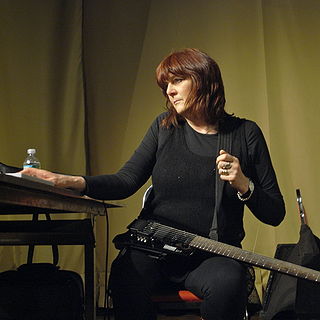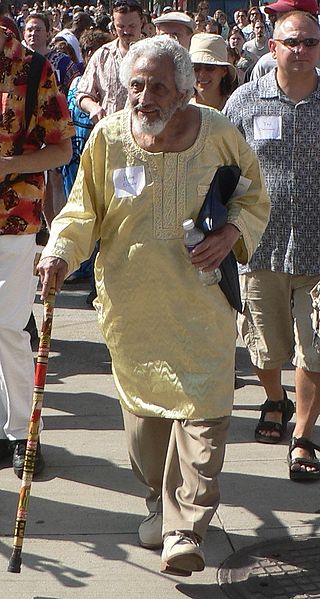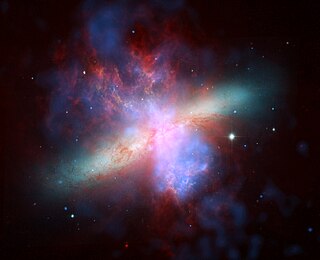Related Research Articles
Electronic music is a genre of music that employs electronic musical instruments, digital instruments, or circuitry-based music technology in its creation. It includes both music made using electronic and electromechanical means. Pure electronic instruments depended entirely on circuitry-based sound generation, for instance using devices such as an electronic oscillator, theremin, or synthesizer. Electromechanical instruments can have mechanical parts such as strings, hammers, and electric elements including magnetic pickups, power amplifiers and loudspeakers. Such electromechanical devices include the telharmonium, Hammond organ, electric piano and the electric guitar.
Ambient music is a genre of music that emphasizes tone and atmosphere over traditional musical structure or rhythm. It may lack net composition, beat, or structured melody. It uses textural layers of sound that can reward both passive and active listening and encourage a sense of calm or contemplation. The genre is said to evoke an "atmospheric", "visual", or "unobtrusive" quality. Nature soundscapes may be included, and the sounds of acoustic instruments such as the piano, strings and flute may be emulated through a synthesizer.
Electronica is both a broad group of electronic-based music styles intended for listening rather than strictly for dancing and a music scene that started in the early 1990s in the United Kingdom. In the United States, the term is mostly used to refer to electronic music generally.
Industrial music is a genre of music that draws on harsh, mechanical, transgressive or provocative sounds and themes. AllMusic defines industrial music as the "most abrasive and aggressive fusion of rock and electronic music" that was "initially a blend of avant-garde electronics experiments and punk provocation". The term was coined in the mid-1970s with the founding of Industrial Records by members of Throbbing Gristle and Monte Cazazza. While the genre name originated with Throbbing Gristle's emergence in the United Kingdom, artists and labels vital to the genre also emerged in the United States and other countries.

Throbbing Gristle were an English music and visual arts group formed in 1975 in Kingston upon Hull by Genesis P-Orridge, Cosey Fanni Tutti, Peter Christopherson, and Chris Carter. They are widely regarded as pioneers of industrial music. Evolving from the experimental performance art group COUM Transmissions, Throbbing Gristle made their public debut in October 1976 on COUM exhibition Prostitution, and released their debut single "United/Zyklon B Zombie" and debut album The Second Annual Report the following year. Lyrical themes mainly revolved around mysticism, extremist political ideologies, sexuality, dark or underground aspects of society, and idiosyncratic manipulation of language.

Genesis Breyer P-Orridge was an English singer-songwriter, musician, poet, performance artist, visual artist, and occultist who rose to notoriety as the founder of the COUM Transmissions artistic collective and lead vocalist of seminal industrial band Throbbing Gristle. P-Orridge was also a founding member of Thee Temple ov Psychick Youth occult group, and fronted the experimental pop rock band Psychic TV.

Psychic TV were an English experimental video art and music group, formed by performance artist Genesis P-Orridge and Scottish musician Alex Fergusson in 1981 after the break-up of Throbbing Gristle.
Dark ambient is a genre of post-industrial music that features an ominous, dark droning and often gloomy, monumental or catacombal atmosphere, partially with discordant overtones. It shows similarities with ambient music, a genre that has been cited as a main influence by many dark ambient artists, both conceptually and compositionally. Although mostly electronically generated, dark ambient also includes the sampling of hand-played instruments and semi-acoustic recording procedures.

Cosey Fanni Tutti is an English performance artist, musician and writer, best known for her time in the avant-garde groups Throbbing Gristle and Chris & Cosey.

Halim Abdul Messieh El-Dabh was an Egyptian-American composer, musician, ethnomusicologist, and educator, who had a career spanning six decades. He is particularly known as an early pioneer of electronic music. In 1944 he composed one of the earliest known works of tape music, or musique concrète. From the late 1950s to early 1960s he produced influential work at the Columbia-Princeton Electronic Music Center.

Space music, also called spacemusic or space ambient, is a subgenre of new-age music and is described as "tranquil, hypnotic and moving". It is derived from ambient music and is associated with lounge music, easy listening, and elevator music.
Peter Mauzey, is an electrical engineer associated with the development of electronic music in the 1950s and 1960s at the Columbia-Princeton Electronic Music Center. He served as an adjunct professor at Columbia University while employed as an engineer at Bell Labs in New Jersey.

Force the Hand of Chance is the debut studio album by English experimental group Psychic TV, released in 1982 by record label Some Bizzare. The first 5,000 pressings came with a bonus album, Themes.

A synthesizer is an electronic musical instrument that generates audio signals. Synthesizers typically create sounds by generating waveforms through methods including subtractive synthesis, additive synthesis and frequency modulation synthesis. These sounds may be altered by components such as filters, which cut or boost frequencies; envelopes, which control articulation, or how notes begin and end; and low-frequency oscillators, which modulate parameters such as pitch, volume, or filter characteristics affecting timbre. Synthesizers are typically played with keyboards or controlled by sequencers, software or other instruments, and may be synchronized to other equipment via MIDI.

The use of electronic music technology in rock music coincided with the practical availability of electronic musical instruments and the genre's emergence as a distinct style. Rock music has been highly dependent on technological developments, particularly the invention and refinement of the synthesizer, the development of the MIDI digital format and computer technology.
Electronic rock is a music genre that involves a combination of rock music and electronic music, featuring instruments typically found within both genres. It originates from the late 1960s, when rock bands began incorporating electronic instrumentation into their music. Electronic rock acts usually fuse elements from other music styles, including punk rock, industrial rock, hip hop, techno, and synth-pop, which has helped spur subgenres such as indietronica, dance-punk, and electroclash.
References
- ↑ Holmes, Thom (2008). "Live Electronic Music and Ambient Music". Electronic and experimental music: technology, music, and culture (3rd ed.). Taylor & Francis. p. 403. ISBN 978-0-415-95781-6 . Retrieved 2011-06-12.
- ↑ Thom Holmes (2015), Electronic and Experimental Music: Technology, Music, and Culture, page 453, Routledge
- ↑ In this interview at 21:46, Genesis P-Orridge, for the first time, specifies the origin date and origin location of the term Industrial Music - Monte Cazassa and Genesis P-Orridge coined the term Industrial Music on Sept 3, 1975 in a park in The London Borough of Hackney, UK.
- ↑ David Toop (March 1996), "A-Z Of Electro", The Wire , no. 145, retrieved 2011-05-29
- ↑ Christoph Cox & Daniel Warner (2004), Audio Culture: Readings in Modern Music, page 396, A&C Black
- ↑ St John, Graham (1 June 2004). Rave Culture and Religion. Routledge. p. 242. ISBN 9781134379729 . Retrieved 25 January 2016.
- ↑ D'Andrea, Anthony (24 January 2007). Global Nomads: Techno and New Age as Transnational Countercultures in Ibiza. Routledge. p. 177. ISBN 9781134110506 . Retrieved 25 January 2016.
- ↑ "The Origins of Synthwave - PART 1".